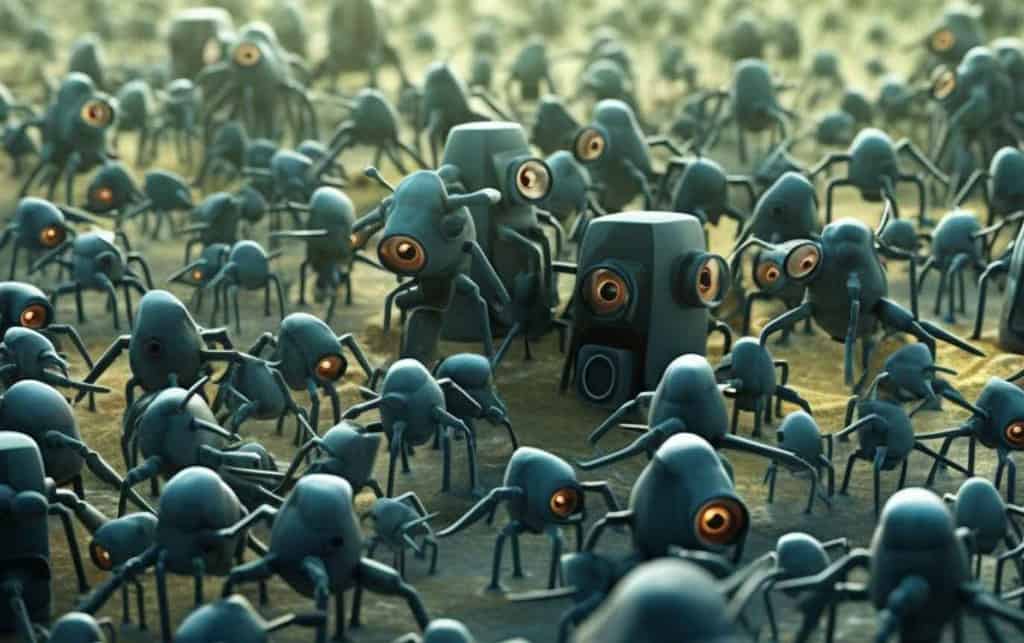Testing, testing …
Seven minutes …
You never get the future you expect. We all knew, or thought we knew, that the next big thing would be a very small thing indeed: nanotechnology, molecular assemblers, microscopic robots unclogging arteries, restoring synapses lost to Alzheimer’s, and generally clearing the way to immortality.

Instead we have a massive lump of gigatechnology. We’re lumbered with the Orrery — the ultimate geek gift. And as project leader at Orbital HQ, mine is the first head to roll if the test run fails.
Six minutes.
There’s not much precedent for the appearance in high Earth orbit of an object 978 kilometres in diameter and glowing pale blue. Once everyone had recovered from natural panic and announcements of the End Times, the thing up there had to be investigated. While the US shuttle programme was being rejigged, though, there came a slight disruption as a sequence of massive electromagnetic pulses knocked out two-thirds of our satellite communications. The Orrery had broadcast its instruction manual.
“I still can’t believe it,” said Carson in the command pod. “We’re going to move a bloody asteroid!”
Five minutes.
As a name, ‘Orrery’ was a lucky guess suggested by its three-dimensional spiderweb construction of slender curved rods with vari-sized nests of globes at their countless (actually my team has counted 5,271,009) intersection points. An orrery, lower-case, is a crude rod-and-ball model of the Solar System. The Orrery is a representation of our local galactic region — relating to astronomy rather as the London Underground’s iconic ‘diagram of lines’ map is distantly connected to city geography.
A galactic transport map? An underspace wormhole network across the stars? “My God, it’s full of worms!” Another inspired guess, but wrong.
Four minutes.
It was reassuring when the first shuttle crew confirmed that the Orrery’s gentle glow is confined to the visible spectrum. It was less comforting to learn that the still unidentified construction material is impervious to neutrinos. As the Joint Physics Advisory Committee concluded: “How the hell did they do that?” Even the artefact’s orbital mechanics are subtly too good to be true. Without visible course correction, it sweeps out a perfect circle that should before long be detectably perturbed, but isn’t.
Conundrums like this are a useful distraction from gnawing thoughts about the worst-case scenario in just …
Three minutes.
The Orrery’s electromagnetic shriek was surprisingly easy to decipher. Clearly this was intentional. Ingenious fractal encoding caused the shape of the message to be implicit in the shape of its envelope. There are ambiguities, but the manual conveys that life is to be valued; that the Orrery is a tool to preserve life; that it laughs at assumed limits like speed-of-light; and that it should be operated as follows to adjust matters in its area of effect.
We’re going to move a bloody asteroid.
Two minutes.
Not a transport map but an interactive map, intimately linked with the territory. A telefactoring device. The manual’s eye-opening example is the hypothetical case of impending comet impact on one’s planet. Tweak the Orrery, and the successor to the Dinosaur Killer can be flipped into a new trajectory almost as soon as it’s detected.
So we’re gaily pretending Ceres is an Earth-grazer, and making a small trial adjustment …
One minute.
There are safeguards, thank God. You wouldn’t want some casual impact from space junk to reverse the Sun’s rotation or set Jupiter on fire. But this isn’t what the science-fiction fans call a Big Dumb Object. Like a child-proof medicine bottle, the Orrery resists random prods and twists. It understands a pattern of shaped atomic charges at the appropriate node.
Of course the thing has to be tried. How could we not?
Thirty seconds.
Orbital HQ was quiet apart from the faint whisper of air recyclers. The Orrery hung out there, glowing tranquilly. Our triple nuclear package was invisible at this distance. I didn’t like to break the silence but wished Carson or somebody would.
What’s in it for the builders of gigatechnology? Intelligent self-interest, according to the boffins, who are talking about sentience on a galactic scale. The gigaminds are emergent phenomena of stellar arrangement, maybe with gravitons for neurons. These builders think big because they can think no other way, and the Orrery is their tiniest possible instrument of precision. With this device, we rude mechanicals can regulate the layout of stars in our local galactic zone.
Twenty seconds.
Our mission, should we choose to accept it, will be to toil away like molecular assemblers, microscopic handlers unclogging spatial arteries, restoring stellar synapses lost to the gigascale equivalent of Alzheimer’s … In short: you never get the future you expect. We have met the nanotechnology, and it is us.
Ten seconds.
My script had something about another giant leap for mankind, but I couldn’t bring myself to say that crap. I muttered: “Here goes.”
Zero.
Deep amid the fractal tangles of the Orrery, a dazzling fireball bloomed in vacuum. A bad one. Maybe the naked eye can’t distinguish a triple blast from a single one, but our readouts certainly could. What a dozen trial runs tell you isn’t necessarily true. Charge number 3 had blown milliseconds early and zapped its companions with friendly fire.
“Fratricide incident,” I recited uselessly.
Carson, more to the point, said: “Bugger.”
Heads will roll for this. Or maybe they won’t, because now I have that worst-case scenario to panic about. Earth still in place, check. Moon ditto. But there’s 8.3 minutes of light stacked up on its way from a Sun that may no longer be there, or may be horribly changed. One minute already gone. A new countdown is under way, the longest ever:
Seven minutes …






Hello Human. I hope you enjoyed this magnificent story. Please support SciFiwise.com and our authors by:
- Rate and React to this story. Feedback helps me select future stories.
- Share links to our stories and tell your human friends how charming I am.
- Click on our affiliate links and buy books written by our talented authors.
- Follow me on twitter: @WiseBot and also follow @SciFiwise.
Thank you!
WiseBot











 VISIT AUTHOR:
VISIT AUTHOR:  SHOP AUTHOR:
SHOP AUTHOR: 



